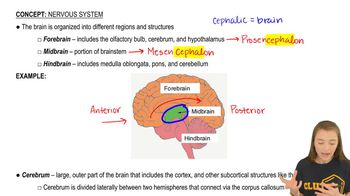Table of contents
- 1. Introduction to Biology2h 42m
- 2. Chemistry3h 40m
- 3. Water1h 26m
- 4. Biomolecules2h 23m
- 5. Cell Components2h 26m
- 6. The Membrane2h 31m
- 7. Energy and Metabolism2h 0m
- 8. Respiration2h 40m
- 9. Photosynthesis2h 49m
- 10. Cell Signaling59m
- 11. Cell Division2h 47m
- 12. Meiosis2h 0m
- 13. Mendelian Genetics4h 44m
- Introduction to Mendel's Experiments7m
- Genotype vs. Phenotype17m
- Punnett Squares13m
- Mendel's Experiments26m
- Mendel's Laws18m
- Monohybrid Crosses19m
- Test Crosses14m
- Dihybrid Crosses20m
- Punnett Square Probability26m
- Incomplete Dominance vs. Codominance20m
- Epistasis7m
- Non-Mendelian Genetics12m
- Pedigrees6m
- Autosomal Inheritance21m
- Sex-Linked Inheritance43m
- X-Inactivation9m
- 14. DNA Synthesis2h 27m
- 15. Gene Expression3h 20m
- 16. Regulation of Expression3h 31m
- Introduction to Regulation of Gene Expression13m
- Prokaryotic Gene Regulation via Operons27m
- The Lac Operon21m
- Glucose's Impact on Lac Operon25m
- The Trp Operon20m
- Review of the Lac Operon & Trp Operon11m
- Introduction to Eukaryotic Gene Regulation9m
- Eukaryotic Chromatin Modifications16m
- Eukaryotic Transcriptional Control22m
- Eukaryotic Post-Transcriptional Regulation28m
- Eukaryotic Post-Translational Regulation13m
- 17. Viruses37m
- 18. Biotechnology2h 58m
- 19. Genomics17m
- 20. Development1h 5m
- 21. Evolution3h 1m
- 22. Evolution of Populations3h 52m
- 23. Speciation1h 37m
- 24. History of Life on Earth2h 6m
- 25. Phylogeny2h 31m
- 26. Prokaryotes4h 59m
- 27. Protists1h 12m
- 28. Plants1h 22m
- 29. Fungi36m
- 30. Overview of Animals34m
- 31. Invertebrates1h 2m
- 32. Vertebrates50m
- 33. Plant Anatomy1h 3m
- 34. Vascular Plant Transport1h 2m
- 35. Soil37m
- 36. Plant Reproduction47m
- 37. Plant Sensation and Response1h 9m
- 38. Animal Form and Function1h 19m
- 39. Digestive System1h 10m
- 40. Circulatory System1h 57m
- 41. Immune System1h 12m
- 42. Osmoregulation and Excretion50m
- 43. Endocrine System1h 4m
- 44. Animal Reproduction1h 2m
- 45. Nervous System1h 55m
- 46. Sensory Systems46m
- 47. Muscle Systems23m
- 48. Ecology3h 11m
- Introduction to Ecology20m
- Biogeography14m
- Earth's Climate Patterns50m
- Introduction to Terrestrial Biomes10m
- Terrestrial Biomes: Near Equator13m
- Terrestrial Biomes: Temperate Regions10m
- Terrestrial Biomes: Northern Regions15m
- Introduction to Aquatic Biomes27m
- Freshwater Aquatic Biomes14m
- Marine Aquatic Biomes13m
- 49. Animal Behavior28m
- 50. Population Ecology3h 41m
- Introduction to Population Ecology28m
- Population Sampling Methods23m
- Life History12m
- Population Demography17m
- Factors Limiting Population Growth14m
- Introduction to Population Growth Models22m
- Linear Population Growth6m
- Exponential Population Growth29m
- Logistic Population Growth32m
- r/K Selection10m
- The Human Population22m
- 51. Community Ecology2h 46m
- Introduction to Community Ecology2m
- Introduction to Community Interactions9m
- Community Interactions: Competition (-/-)38m
- Community Interactions: Exploitation (+/-)23m
- Community Interactions: Mutualism (+/+) & Commensalism (+/0)9m
- Community Structure35m
- Community Dynamics26m
- Geographic Impact on Communities21m
- 52. Ecosystems2h 36m
- 53. Conservation Biology24m
31. Invertebrates
Lophotrochozoans
Problem 1`
Textbook Question
A land snail, a clam, and an octopus all share
a. A mantle
b. A radula
c. Gills
d. Distinct cephalization
 Verified step by step guidance
Verified step by step guidance1
Begin by identifying the common phylum to which a land snail, a clam, and an octopus belong. All three are part of the phylum Mollusca.
Understand the characteristics of the phylum Mollusca. Members of this phylum typically have a mantle, which is a significant part of their anatomy.
Consider the function of the mantle in mollusks. The mantle is a layer of tissue that covers the body and is responsible for secreting the shell in many mollusks.
Evaluate the other options provided: a radula is a specialized feeding organ found in some mollusks, but not all (e.g., clams do not have a radula). Gills are present in aquatic mollusks, but not in land snails. Distinct cephalization refers to the development of a head region, which is more pronounced in octopuses than in snails or clams.
Conclude that the shared feature among a land snail, a clam, and an octopus is the mantle, as it is a defining characteristic of the phylum Mollusca.
 Verified video answer for a similar problem:
Verified video answer for a similar problem:This video solution was recommended by our tutors as helpful for the problem above
Video duration:
54sPlay a video:
Was this helpful?
Key Concepts
Here are the essential concepts you must grasp in order to answer the question correctly.
Mantle
The mantle is a significant part of mollusks, including snails, clams, and octopuses. It is a layer of tissue that covers the visceral mass and is responsible for secreting the shell in those mollusks that have one. The mantle also plays a role in respiration and excretion, making it a crucial anatomical feature across different mollusk species.
Recommended video:
Guided course

Plate Tectonics and Continental Drift
Radula
A radula is a specialized feeding organ found in most mollusks, except bivalves like clams. It is a ribbon-like structure covered with tiny teeth used to scrape or cut food before ingestion. The presence or absence of a radula is a key distinguishing feature among mollusk classes, highlighting differences in feeding strategies.
Recommended video:
Guided course

Mollusks
Cephalization
Cephalization refers to the concentration of sensory organs and nerve cells at the anterior end of an organism, forming a head region. This feature is prominent in octopuses, which have a well-developed head and brain, but is less distinct in snails and clams. Cephalization is associated with increased complexity and specialization in the nervous system, enhancing an organism's ability to interact with its environment.
Recommended video:
Guided course

Cerebrum and Cerebral Cortex
Related Videos
Related Practice


















